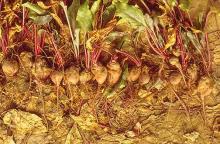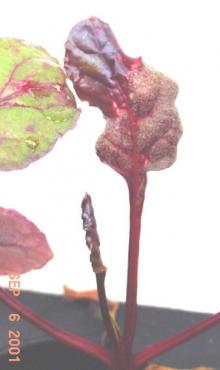Cause The fungus-like microorganism, Peronospora farinosa (= P. betae = P. schachtii), causes disease mostly west of the Cascade Range. In the Willamette Valley of Oregon, susceptible varieties often are a total loss. The microorganism survives in infected crop residues and in wild or volunteer Beta spp.; the downy mildew on lambsquarters does not affect beet. Peronospora farinosa also can survive in seed to a limited extent. Optimal temperatures for infection are 45°F to 59°F; little infection occurs above 68°F.
Symptoms All aboveground plant parts may be affected, and young leaves are especially sensitive, from where the pathogen grows into the crown. Large, light green leaf spots develop on the upper leaf surfaces. Under moist conditions, a white to gray mold appears on the lower or upper leaf surfaces. Affected leaves may wilt, and then die. If environmental conditions become unfavorable for downy mildew, plants may show recovery by developing healthy leaves, or other pathogens may be encouraged. During fall wet periods, most young petioles or leaves are covered with a fungal growth that often moves into the crown. Crown infection causes excessive leaf proliferation, which in turn causes misshapen bulbs. Crown infections may permit other root-decay organisms to invade the plant.
In beet seed crops, systemic crown infections of stecklings may result in severe stand and seed yield losses. Flower and seed heads can be attacked directly with serious losses of seed production.
Cultural control
- The variety 'F.M. Detroit Dark Red' shows resistance.
- Increase plant spacing, and avoid excess nitrogen.
Chemical control Although fungicide applications do not protect perfectly, they are useful when disease conditions are severe. In beet seed crops, steckling beds should receive protective sprays. No effective controls are available for seed head infection.
- Copper formulations (Group M1) are not recommended as stand-alone materials.
- Badge SC at 0.75 to 4 pints/A on 10- to 14-day intervals. Preharvest interval is 0 days. 48-hr reentry.
- C-O-C-S WDG at 2 to 2.5 lb/A in a minimum of 25 gal/A water (ground) or 3 gal/A water (air). 48-hr reentry.
- Cueva at 0.5 to 2 gal/100 gal water on 7- to 10-day intervals. May be applied on the day of harvest. 4-hr reentry. O
- Curzate 60 DF (Group 27) at 3.2 oz/A is available for use on table beet seed crops in Oregon (SLN OR-240012) and Beta crops in Washington only (SLN WA-200001). Use only in combination with another registered protectant fungicide. 12-hr reentry.
- Mancozeb formulations (Group M3) are labeled.
- Dithane F45 Rainshield at 1.5 quart/A on 7- to 10-day intervals can be used on seed crops only. Washington and Oregon only (SLN WA-220008, SLN OR-240011). 24-hr reentry.
- Roper DF Rainshield at 2 lb/A on 7- to 10-day intervals can be used on seed crops Washington (SLN WA-1300003). 24-hr reentry.
- Phosphonates (Group P7) should be quite effective.
- Fosphite at 1 to 3 quarts/A on 14- to 21-day intervals. See label for interval time requirement with copper-based products. 4-hr reentry.
- Fungi-phite at 1 to 3 quarts/A on 7- to 14-day intervals. See label for interval time requirement with copper-based products. 4-hr reentry.
- Rampart at 1 to 3 quarts/A on 14- to 21-day intervals. See label for interval time requirement with copper-based products. May be applied up to the day of harvest. 4-hr reentry.
- Regalia (Group P5) at 0.5 to 4 quarts/A plus another fungicide on 7- to 10-day intervals. Does not benefit from the addition of an adjuvant. Preharvest interval is 0 days. 4-hr reentry. O
- Trilogy at 0.5% to 1%. Not labeled for use in Oregon. Do not use above 90°F or when plants are under heat or moisture stress. Do not use when foliage is wet as good coverage is essential. 4-hr reentry. O
Biological control
- Actinovate AG at 3 to 12 oz/A as a foliar spray on 7- to 14-day intervals. 4-hr reentry. O
- Actinovate Lawn & Garden at 1/2 to 1 teaspoon/gal water. H O
- Sonata at 2 to 4 quarts/A on 7- to 14-day intervals. Efficacy is unknown in the Pacific Northwest. Can be applied up to and on the day of harvest. 4-hr reentry. O
- Stargus at 2 to 4 quarts/A plus a nonionic surfactant on 7- to 10-day intervals. Preharvest interval is 0 days. 4-hr reentry. O
Reference Harveson, R.M., Hanson, L.E., and Hein, G.L. 2009. Compendium of Beet Diseases and Pests, 2nd Ed. St. Paul, MN: APS Press.



